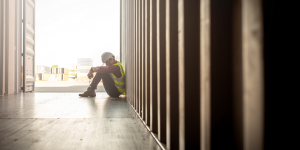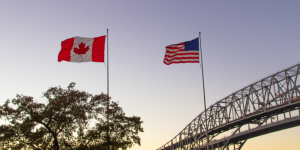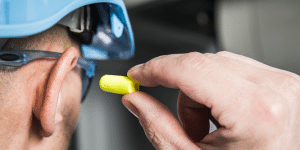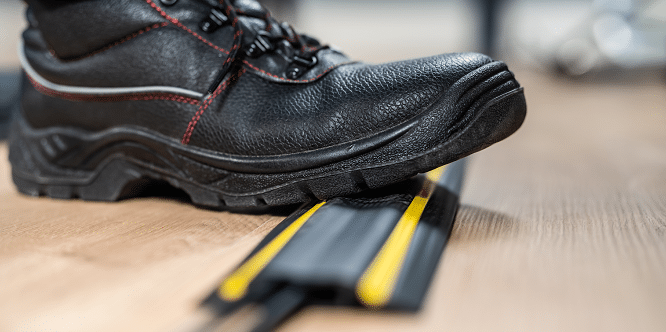Although often preventable, falls, slips, and trips are a prevalent workplace safety concern. According to the U.S. Bureau of Labor Statistics, in 2020, this category of accidents accounted for roughly 18 percent of the total nonfatal work-related injuries resulting in days away from work.
Falls, slips, and trips have negative repercussions in the workplace. They adversely impact employee health and well-being, reduce productivity, and impact the company’s bottom line. Therefore, a proactive approach toward preventing falls, slips, and trips is crucial.
Employers and employees should understand the main causes of these accidents and how to mitigate the associated hazards. Read on to discover the top workplace action tips for avoiding slips, trips, and falls.
Jump Ahead
- Causes of Workplace Slips, Trips, and Falls
- Top Tips to Prevent Slips, Trips, and Falls in the Workplace
- 1. Appropriate Footwear
- 2. Proper Clothing
- 3. Safe Buildings
- 4. Adequate Lighting
- 5. Housekeeping
- 6. Invest in Safety Equipment
- 7. Clear and Organized Workspaces
- 8. Training and Awareness
- 9. Implementing Safety Regulations
- 10. Regular Breaks
- 11. Open Communication Channels
- 12. Emergency Preparedness
- 13. Constant Review and Improvement
- Preventing Falls, Slips, and Trips in the Workplace | In Conclusion
- You May Also Be Interested In…
Causes of Workplace Slips, Trips, and Falls
Various hazardous conditions and practices cause workplace slips, trips, and falls. These incidents can often be traced back to wet or uneven surfaces, cluttered workspaces, improper footwear, inadequate lighting, and lack of safety equipment.
- Wet surfaces could result from spills or cleaning processes, increasing the risk of slipping.
- Uneven surfaces may be due to poorly maintained floors or unexpected obstacles, producing tripping hazards.
- Poor housekeeping can lead to cluttered walkways, posing trip hazards
- Inappropriate footwear, especially those without sufficient grip, can contribute to slips, especially on smooth surfaces
- Poor lighting may make it harder to see hazards, thus increasing the risk of slips, trips, and falls
- Lack of necessary safety equipment, such as handrails or non-slip mats, can make certain areas more prone to accidents
The above issues highlight areas employers can focus on to prevent workplace slips, trips, and falls.
Top Tips to Prevent Slips, Trips, and Falls in the Workplace
1. Appropriate Footwear
Choosing the right footwear is one of the most practical steps to prevent slips, trips, and falls. Workers in high-risk industries such as construction, manufacturing, or food service should wear slip-resistant shoes with sturdy soles. Employers can facilitate this by providing footwear guidelines or supplying appropriate footwear.
2. Proper Clothing
Loose, ill-fitting clothing can be a tripping hazard, particularly around machinery or equipment. Employers can provide uniforms or dress code guidelines to ensure employees make appropriate safety-specific clothing choices.
3. Safe Buildings
Regular checks for required building maintenance can go a long way toward avoiding slips, trips, and falls. Arrange repairs of any uneven surfaces, loose floorboards, or torn carpeting.
4. Adequate Lighting
Proper lighting is paramount for preventing workplace slips, trips, and falls, as it significantly enhances visibility and allows employees to discern potential hazards.
Areas with poor lighting can obscure obstacles or spillages that can lead to incidents. This problem worsens in areas with stairs, entrances and exits, warehouses, or storage areas with greater potential for clutter and uneven surfaces.
Workplaces should regularly evaluate their lighting conditions, considering factors like natural light and the type of work, to ensure a safe environment. By investing in high-quality, well-placed lighting, businesses can greatly reduce the incidence of slip, trip, and fall accidents, promoting employee safety and productivity.
5. Housekeeping
Good housekeeping practices are crucial for maintaining a safe workplace and significantly reducing the likelihood of accidents such as slips, trips, and falls. Such methods involve maintaining clean, uncluttered, and well-organized work environments.
Regular cleaning schedules, immediate clean-up of spills, and proper disposal of waste materials can help eliminate slippery surfaces. Visible warning signs should be displayed when a surface is wet to warn workers to tread carefully. Keeping passageways, corridors, and work areas free from obstructions and ensuring cables, cords, and wires are properly managed and tucked away can prevent tripping hazards.
By implementing and adhering to good housekeeping practices, workplaces can greatly minimize the risks associated with slips, trips, and falls, fostering a safer and more productive environment for everyone.
6. Invest in Safety Equipment
Safety equipment is indispensable in preventing workplace slips, trips, and falls. Handrails, for example, provide stability and support, especially on stairs or uneven surfaces, reducing the risk of falls significantly. They should be sturdy, easily accessible, and present on both sides of a staircase or walkway for optimal safety.
Non-slip mats are essential in areas prone to wetness or spills, such as kitchens, restrooms, and entrances. These mats have a high-grip surface that provides traction underfoot, minimizing the likelihood of slipping. Safety tapes or anti-skid paints on floor surfaces can increase friction and facilitate safe pathways.
7. Clear and Organized Workspaces
Keeping workspaces tidy is another key measure. Employers should provide adequate storage to keep items off the floor. Employees, in turn, should keep their workspace free from clutter, removing any items from walkways that could pose a tripping hazard.
8. Training and Awareness
Regular safety training can help employees understand the risks of slips, trips, and falls. The training could include identifying hazards, properly using safety equipment, and reporting unsafe conditions. Employers should foster a culture of safety where employees feel responsible for their and their colleagues’ safety.
9. Implementing Safety Regulations
Employers must ensure that all safety regulations and guidelines are strictly adhered to. Examples include providing and correctly using safety equipment such as harnesses for employees working at height, non-slip mats in slippery areas, and handrails in stairwells.
10. Regular Breaks
Long hours of continuous work may lead to fatigue and loss of concentration, increasing the likelihood of accidents. Regular breaks can help employees stay fresh, safe, and productive.
11. Open Communication Channels
Create an environment where employees feel comfortable reporting potential hazards or near misses. Facilitate such an environment through regular meetings, suggestion boxes, or an open-door policy. Immediate action should be taken to address the reported issues, thus preventing potential accidents.
12. Emergency Preparedness
Despite all precautions, accidents may still occur. A robust emergency response plan, including access to first aid and trained personnel, can significantly minimize the impact of any unfortunate incident.
13. Constant Review and Improvement
Workplace safety is not a one-time task but an ongoing process. Employers should continually review and improve their safety policies and procedures based on employee feedback, incident reports, and changes in industry standards or regulations.
Preventing Falls, Slips, and Trips in the Workplace | In Conclusion
Maintaining a safe workplace requires a collective effort from employers and employees. A proactive approach to preventing slips, trips, and falls by following the above measures can go a long way toward creating a safer work environment.
For related reading, find out how to prevent slips, trips, and falls on snowy and icy job sites.
You May Also Be Interested In…
- Do You Have Reasonable Suspicion?
 Employers cannot initiate reasonable suspicion testing without first going through the 5-step process. Reasonable suspicion training provides critical information about how to initiate reasonable suspicion testing, including the 5-step process and other tools that employers can use to help manage the misuse of alcohol and drugs in the workplace.
Employers cannot initiate reasonable suspicion testing without first going through the 5-step process. Reasonable suspicion training provides critical information about how to initiate reasonable suspicion testing, including the 5-step process and other tools that employers can use to help manage the misuse of alcohol and drugs in the workplace. - An Employer’s Guide: What You and Your Employees Need to Know About DOT Drug & Alcohol Testing
 When implementing or maintaining DOT Drug & Alcohol testing, there are key areas that employers should consider.
When implementing or maintaining DOT Drug & Alcohol testing, there are key areas that employers should consider. - SureHire Occupational Testing Acquires COHR Health: A Positive Step Towards Safe, Healthy, Productive Workforces and Communities
 We are thrilled to announce that today, May 6, 2024, SureHire Occupational Testing has officially acquired COHR Health, a well-known leader in occupational health services. Read on…
We are thrilled to announce that today, May 6, 2024, SureHire Occupational Testing has officially acquired COHR Health, a well-known leader in occupational health services. Read on… - Occupational Testing Use Case – Mining
 In this case study, we will explore how mining companies can use various types of occupational tests to reduce Total Recordable Incident Rates (TRIR) long term.
In this case study, we will explore how mining companies can use various types of occupational tests to reduce Total Recordable Incident Rates (TRIR) long term. - 9 Strategies to Keep Workers Cool on Drilling Sites During Hot Summer Months
 This article delves into strategies to keep workers cool and safe on drilling sites during the hot summer months.
This article delves into strategies to keep workers cool and safe on drilling sites during the hot summer months. - Hearing Conservation Basics: How to Manage Occupational Noise
 Learn how to proactively mitigate occupational noise risks and help prevent NIHL among workers.
Learn how to proactively mitigate occupational noise risks and help prevent NIHL among workers.

